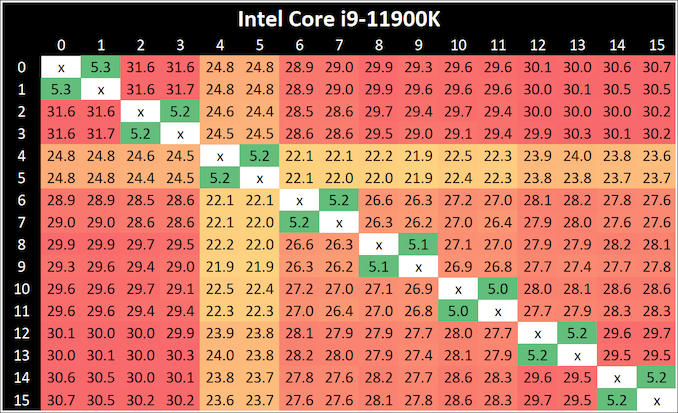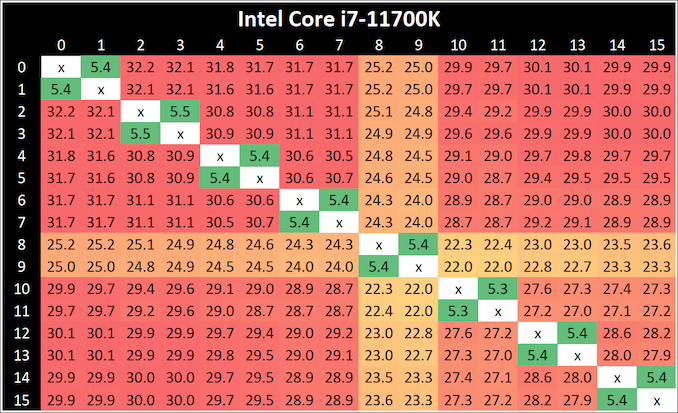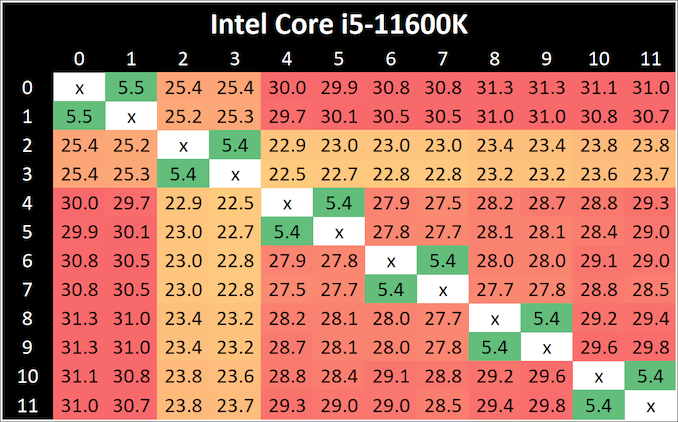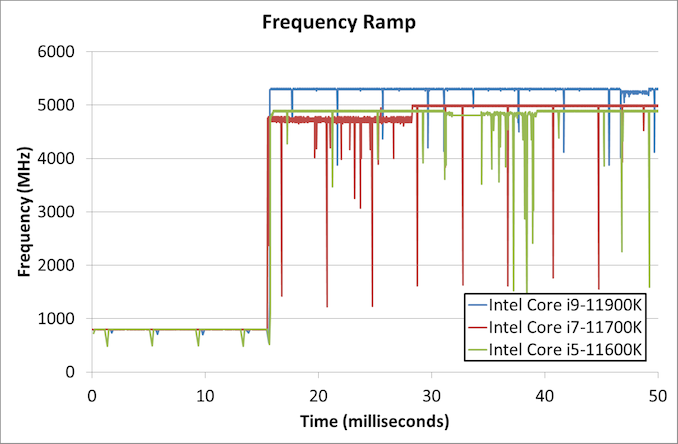Intel Rocket Lake (14nm) Review: Core i9-11900K, Core i7-11700K, and Core i5-11600K
by Dr. Ian Cutress on March 30, 2021 10:03 AM EST- Posted in
- CPUs
- Intel
- LGA1200
- 11th Gen
- Rocket Lake
- Z590
- B560
- Core i9-11900K
CPU Tests: Microbenchmarks
Core-to-Core Latency
As the core count of modern CPUs is growing, we are reaching a time when the time to access each core from a different core is no longer a constant. Even before the advent of heterogeneous SoC designs, processors built on large rings or meshes can have different latencies to access the nearest core compared to the furthest core. This rings true especially in multi-socket server environments.
But modern CPUs, even desktop and consumer CPUs, can have variable access latency to get to another core. For example, in the first generation Threadripper CPUs, we had four chips on the package, each with 8 threads, and each with a different core-to-core latency depending on if it was on-die or off-die. This gets more complex with products like Lakefield, which has two different communication buses depending on which core is talking to which.
If you are a regular reader of AnandTech’s CPU reviews, you will recognize our Core-to-Core latency test. It’s a great way to show exactly how groups of cores are laid out on the silicon. This is a custom in-house test built by Andrei, and we know there are competing tests out there, but we feel ours is the most accurate to how quick an access between two cores can happen.
All three CPUs exhibit the same behaviour - one core seems to be given high priority, while the rest are not.
Frequency Ramping
Both AMD and Intel over the past few years have introduced features to their processors that speed up the time from when a CPU moves from idle into a high powered state. The effect of this means that users can get peak performance quicker, but the biggest knock-on effect for this is with battery life in mobile devices, especially if a system can turbo up quick and turbo down quick, ensuring that it stays in the lowest and most efficient power state for as long as possible.
Intel’s technology is called SpeedShift, although SpeedShift was not enabled until Skylake.
One of the issues though with this technology is that sometimes the adjustments in frequency can be so fast, software cannot detect them. If the frequency is changing on the order of microseconds, but your software is only probing frequency in milliseconds (or seconds), then quick changes will be missed. Not only that, as an observer probing the frequency, you could be affecting the actual turbo performance. When the CPU is changing frequency, it essentially has to pause all compute while it aligns the frequency rate of the whole core.
We wrote an extensive review analysis piece on this, called ‘Reaching for Turbo: Aligning Perception with AMD’s Frequency Metrics’, due to an issue where users were not observing the peak turbo speeds for AMD’s processors.
We got around the issue by making the frequency probing the workload causing the turbo. The software is able to detect frequency adjustments on a microsecond scale, so we can see how well a system can get to those boost frequencies. Our Frequency Ramp tool has already been in use in a number of reviews.
From an idle frequency of 800 MHz, It takes ~16 ms for Intel to boost to the top frequency for both the i9 and the i5. The i7 was most of the way there, but took an addition 10 ms or so.














279 Comments
View All Comments
robbro9 - Tuesday, March 30, 2021 - link
Has anyone seen igpu tests? Toms did not test them either apparently. Given the challenges in locating add in gpu's the integrated should be of high interest for many. I know I just put together a 3400G system, just cause its about the best you can get graphics wise without paying scalper pricing. Was curious if these were as good or better?Lookslikeamhere - Tuesday, March 30, 2021 - link
Phoronix has someilt24 - Tuesday, March 30, 2021 - link
Hexus has some...https://hexus.net/tech/reviews/cpu/147440-intel-co...robbro9 - Tuesday, March 30, 2021 - link
Thanks, those are kinda disappointing. The 3400G I put together does roughly 13K night raid, 1.4K time spy, while the new UHD 750 does 9.5K and .7k respectively. I figured it would be closer. Guess its still king of the hill for desktop integrated... which is kinda sad. I wish AMD would up their integrated game, or Tigerlake was available for desktop...Slash3 - Tuesday, March 30, 2021 - link
Tiger Lake is 96EU, RKL-S is only 36 or 24EU. It was always going to be a small bump over Comet Lake.antonkochubey - Tuesday, March 30, 2021 - link
RKL is 32EU. Exactly a third of Tiger Lake.Slash3 - Tuesday, March 30, 2021 - link
Whoops, yes. Typo.32EU on the i5-11500 and above, 24EU on the i5-11400 parts.
Pmaciel - Tuesday, March 30, 2021 - link
"The Core i9-11900K in our test peaks up to 296 W, showing temperatures of 104ºC""The cooler we’re using on this test is arguably the best air cooling on the market – a 1.8 kilogram full copper ThermalRight Ultra Extreme, paired with a 170 CFM high static pressure fan from Silverstone."
Not even the much-derided AMD FX-9590 got this far
blppt - Tuesday, March 30, 2021 - link
To be fair, the 9590 was such a POS that it was a blast furnace AND wasn't really competitive in real life usage.At least this cpu is competitive, performance wise. Everything else is laughable---or would be if AMD wasn't having a nightmare keeping their 59xx series in stock.
TheinsanegamerN - Tuesday, March 30, 2021 - link
Credit where it’s due, bulldozer was easier to cool